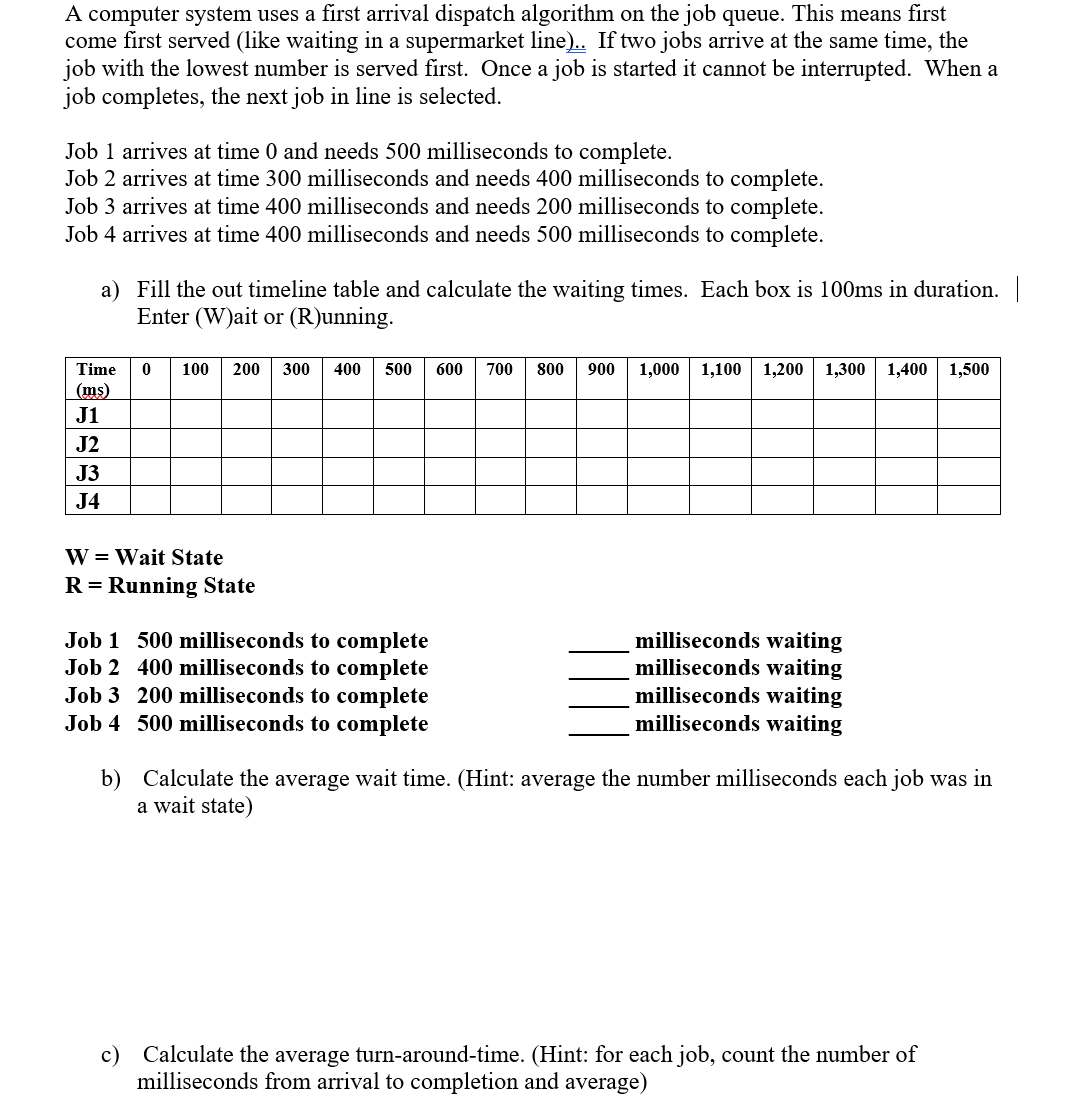A computer system uses a first arrival dispatch algorithm on the job queue. This means first come first served (like waiting in a supermarket line). If two jobs arrive at the same time, the job with the lowest number is served first. Once a job is started it cannot be interrupted. When a job completes, the next job in line is selected. Job 1 arrives at time 0 and needs 500 milliseconds to complete. Job 2 arrives at time 300 milliseconds and needs 400 milliseconds to complete. Job 3 arrives at time 400 milliseconds and needs 200 milliseconds to complete. Job 4 arrives at time 400 milliseconds and needs 500 milliseconds to complete. a) Fill the out timeline table and calculate the waiting times. Each box is 100ms in duration. Enter (W)ait or (R)unning. Time 100 200 300 400 500 600 700 800 900 1,000 1,100 1,200 1,300 1,400 1,500 (ms) J1 J2 J3 J4 W = Wait State R= Running State Job 1 500 milliseconds to complete Job 2 400 milliseconds to complete Job 3 200 milliseconds to complete Job 4 500 milliseconds to complete milliseconds waiting milliseconds waiting milliseconds waiting milliseconds waiting b) Calculate the average wait time. (Hint: average the number milliseconds each job was in a wait state) c) Calculate the average turn-around-time. (Hint: for each job, count the number of milliseconds from arrival to completion and average)
A computer system uses a first arrival dispatch algorithm on the job queue. This means first come first served (like waiting in a supermarket line). If two jobs arrive at the same time, the job with the lowest number is served first. Once a job is started it cannot be interrupted. When a job completes, the next job in line is selected. Job 1 arrives at time 0 and needs 500 milliseconds to complete. Job 2 arrives at time 300 milliseconds and needs 400 milliseconds to complete. Job 3 arrives at time 400 milliseconds and needs 200 milliseconds to complete. Job 4 arrives at time 400 milliseconds and needs 500 milliseconds to complete. a) Fill the out timeline table and calculate the waiting times. Each box is 100ms in duration. Enter (W)ait or (R)unning. Time 100 200 300 400 500 600 700 800 900 1,000 1,100 1,200 1,300 1,400 1,500 (ms) J1 J2 J3 J4 W = Wait State R= Running State Job 1 500 milliseconds to complete Job 2 400 milliseconds to complete Job 3 200 milliseconds to complete Job 4 500 milliseconds to complete milliseconds waiting milliseconds waiting milliseconds waiting milliseconds waiting b) Calculate the average wait time. (Hint: average the number milliseconds each job was in a wait state) c) Calculate the average turn-around-time. (Hint: for each job, count the number of milliseconds from arrival to completion and average)
Database System Concepts
7th Edition
ISBN:9780078022159
Author:Abraham Silberschatz Professor, Henry F. Korth, S. Sudarshan
Publisher:Abraham Silberschatz Professor, Henry F. Korth, S. Sudarshan
Chapter1: Introduction
Section: Chapter Questions
Problem 1PE
Related questions
Question
question

Transcribed Image Text:A computer system uses a first arrival dispatch algorithm on the job queue. This means first
come first served (like waiting in a supermarket line). If two jobs arrive at the same time, the
job with the lowest number is served first. Once a job is started it cannot be interrupted. When a
job completes, the next job in line is selected.
Job 1 arrives at time 0 and needs 500 milliseconds to complete.
Job 2 arrives at time 300 milliseconds and needs 400 milliseconds to complete.
Job 3 arrives at time 400 milliseconds and needs 200 milliseconds to complete.
Job 4 arrives at time 400 milliseconds and needs 500 milliseconds to complete.
a) Fill the out timeline table and calculate the waiting times. Each box is 100ms in duration.
Enter (W)ait or (R)unning.
Time
100
200
300
400
500
600
700
800
900
1,000
1,100
1,200
1,300
1,400
1,500
(ms)
J1
J2
J3
J4
W = Wait State
R= Running State
Job 1 500 milliseconds to complete
Job 2 400 milliseconds to complete
Job 3 200 milliseconds to complete
Job 4 500 milliseconds to complete
milliseconds waiting
milliseconds waiting
milliseconds waiting
milliseconds waiting
b) Calculate the average wait time. (Hint: average the number milliseconds each job was in
a wait state)
c) Calculate the average turn-around-time. (Hint: for each job, count the number of
milliseconds from arrival to completion and average)
Expert Solution
This question has been solved!
Explore an expertly crafted, step-by-step solution for a thorough understanding of key concepts.
Step by step
Solved in 2 steps with 1 images

Knowledge Booster
Learn more about
Need a deep-dive on the concept behind this application? Look no further. Learn more about this topic, computer-science and related others by exploring similar questions and additional content below.Recommended textbooks for you

Database System Concepts
Computer Science
ISBN:
9780078022159
Author:
Abraham Silberschatz Professor, Henry F. Korth, S. Sudarshan
Publisher:
McGraw-Hill Education

Starting Out with Python (4th Edition)
Computer Science
ISBN:
9780134444321
Author:
Tony Gaddis
Publisher:
PEARSON

Digital Fundamentals (11th Edition)
Computer Science
ISBN:
9780132737968
Author:
Thomas L. Floyd
Publisher:
PEARSON

Database System Concepts
Computer Science
ISBN:
9780078022159
Author:
Abraham Silberschatz Professor, Henry F. Korth, S. Sudarshan
Publisher:
McGraw-Hill Education

Starting Out with Python (4th Edition)
Computer Science
ISBN:
9780134444321
Author:
Tony Gaddis
Publisher:
PEARSON

Digital Fundamentals (11th Edition)
Computer Science
ISBN:
9780132737968
Author:
Thomas L. Floyd
Publisher:
PEARSON

C How to Program (8th Edition)
Computer Science
ISBN:
9780133976892
Author:
Paul J. Deitel, Harvey Deitel
Publisher:
PEARSON

Database Systems: Design, Implementation, & Manag…
Computer Science
ISBN:
9781337627900
Author:
Carlos Coronel, Steven Morris
Publisher:
Cengage Learning

Programmable Logic Controllers
Computer Science
ISBN:
9780073373843
Author:
Frank D. Petruzella
Publisher:
McGraw-Hill Education